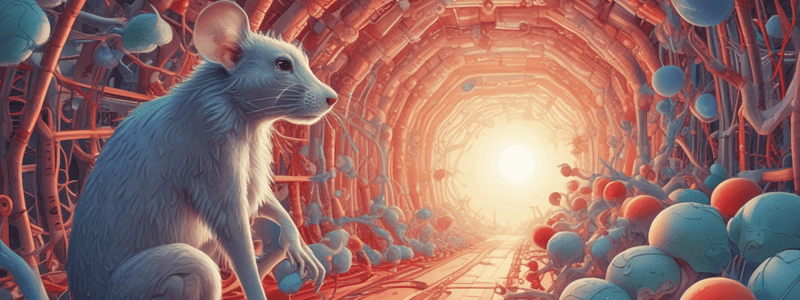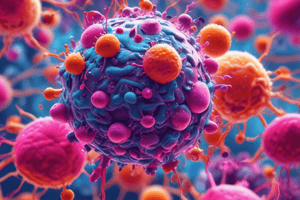Podcast
Questions and Answers
What is the main difference between conventional gene knockout and conditional gene knockout?
What is the main difference between conventional gene knockout and conditional gene knockout?
Conventional gene knockout involves the complete deletion of a gene, whereas conditional gene knockout allows for the controlled expression of a gene in a specific cell type or at a specific time point, usually in adulthood.
What is the purpose of backcrossing knockout mice onto a wildtype mouse?
What is the purpose of backcrossing knockout mice onto a wildtype mouse?
To ensure the rest of the genome matches the parent strain, which is used as a control.
What is the difference between C57Bl/6 and BALB/c mouse strains in terms of their susceptibility to allergic airway inflammation?
What is the difference between C57Bl/6 and BALB/c mouse strains in terms of their susceptibility to allergic airway inflammation?
C57Bl/6 is generally considered a Th1-skewed strain, whereas BALB/c is regarded as a Th2-skewed strain
What is the purpose of the Cre-LoxP system in reporter mice?
What is the purpose of the Cre-LoxP system in reporter mice?
What is the advantage of using conditional gene knockout over conventional gene knockout in studying disease mechanisms?
What is the advantage of using conditional gene knockout over conventional gene knockout in studying disease mechanisms?
What is the purpose of adoptive transfer in mouse research, and how does it facilitate the tracking of different cell types?
What is the purpose of adoptive transfer in mouse research, and how does it facilitate the tracking of different cell types?
What is the difference between conventional and conditional knockout mice, and what are the advantages of conditional knockout strains?
What is the difference between conventional and conditional knockout mice, and what are the advantages of conditional knockout strains?
How does the Cre/LoxP system enable researchers to investigate the role of specific cells in disease conditions?
How does the Cre/LoxP system enable researchers to investigate the role of specific cells in disease conditions?
What is the significance of CRISPR/Cas9 system in mouse research, and how does it compare to traditional knockout techniques?
What is the significance of CRISPR/Cas9 system in mouse research, and how does it compare to traditional knockout techniques?
What is the benefit of using mouse models to investigate the role of specific cells in disease conditions, and how do they compare to human models?
What is the benefit of using mouse models to investigate the role of specific cells in disease conditions, and how do they compare to human models?
What is the primary advantage of using Balb/c mice as models for antibody-driven diseases?
What is the primary advantage of using Balb/c mice as models for antibody-driven diseases?
Why are C57/Bl6 mice preferred for studying infectious diseases?
Why are C57/Bl6 mice preferred for studying infectious diseases?
What is required for a scientist to work with protected experimental animals in the UK?
What is required for a scientist to work with protected experimental animals in the UK?
What is the significance of project licenses in the UK?
What is the significance of project licenses in the UK?
How do the immune responses of C57/Bl6 and Balb/c mice differ?
How do the immune responses of C57/Bl6 and Balb/c mice differ?
What is a major ethical concern related to using Balb/c mice in research?
What is a major ethical concern related to using Balb/c mice in research?
What is the significance of the high degree of similarity in transcription factor networks between mouse and human genomes, and how does it contribute to the use of mice as model organisms?
What is the significance of the high degree of similarity in transcription factor networks between mouse and human genomes, and how does it contribute to the use of mice as model organisms?
How do genetic manipulation techniques in mice, such as gene knockout, facilitate the study of immune system disorders and what are the advantages of using mice in this context?
How do genetic manipulation techniques in mice, such as gene knockout, facilitate the study of immune system disorders and what are the advantages of using mice in this context?
What is the significance of using GFP-labelled immune cells in tumour cell tracking and what insights does it provide into the mechanisms of tumour development and progression?
What is the significance of using GFP-labelled immune cells in tumour cell tracking and what insights does it provide into the mechanisms of tumour development and progression?
How does the adoptive transfer of immune cells in mice facilitate the study of immune cell function and what are the advantages of using this approach?
How does the adoptive transfer of immune cells in mice facilitate the study of immune cell function and what are the advantages of using this approach?
How do mouse models of chronic lung disease facilitate the study of immune cell function and what insights do they provide into the mechanisms of disease?
How do mouse models of chronic lung disease facilitate the study of immune cell function and what insights do they provide into the mechanisms of disease?
What characteristics make Drosophila a suitable model organism for studying human biology and diseases?
What characteristics make Drosophila a suitable model organism for studying human biology and diseases?
What is the significance of conserved genes in model organisms, and how does it relate to their position in the evolutionary tree?
What is the significance of conserved genes in model organisms, and how does it relate to their position in the evolutionary tree?
What is the significance of the 60% shared genetic code between humans and Drosophila, and how does it facilitate the use of Drosophila as a model organism?
What is the significance of the 60% shared genetic code between humans and Drosophila, and how does it facilitate the use of Drosophila as a model organism?
What is the purpose of the wild type strain of Drosophila in lab studies, and how does it differ from other strains?
What is the purpose of the wild type strain of Drosophila in lab studies, and how does it differ from other strains?
What are the characteristics of the male and female wild type strains of Drosophila, and how do they differ from each other?
What are the characteristics of the male and female wild type strains of Drosophila, and how do they differ from each other?
What is the significance of the life cycle of Drosophila, including the stages of egg, larva, pupa, and adult, in understanding its biology and behavior?
What is the significance of the life cycle of Drosophila, including the stages of egg, larva, pupa, and adult, in understanding its biology and behavior?
What are the advantages of using Caenorhabditis elegans as a model organism?
What are the advantages of using Caenorhabditis elegans as a model organism?
What is the significance of the invariant cell lineage in Caenorhabditis elegans?
What is the significance of the invariant cell lineage in Caenorhabditis elegans?
What is the purpose of forward and reverse genetics in studying gene function in Caenorhabditis elegans?
What is the purpose of forward and reverse genetics in studying gene function in Caenorhabditis elegans?
How does the life cycle of Caenorhabditis elegans facilitate its use as a model organism?
How does the life cycle of Caenorhabditis elegans facilitate its use as a model organism?
What is the significance of the body systems in Caenorhabditis elegans?
What is the significance of the body systems in Caenorhabditis elegans?
What is the advantage of using Caenorhabditis elegans to study developmental biology and cell biology?
What is the advantage of using Caenorhabditis elegans to study developmental biology and cell biology?
What is the significance of the dauer stage in Caenorhabditis elegans?
What is the significance of the dauer stage in Caenorhabditis elegans?
Flashcards are hidden until you start studying





